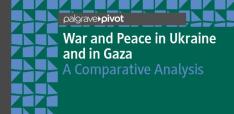The US and its Two Cold Wars

My new book, America’s Two Cold Wars: From Hegemony to Decline?, compares the US Cold War with the Soviet Union with its emerging one with China. Two basic questions are posed: How different as a strategic competitor was the USSR to current China? How different is America today to its former self when confronting the Soviets? To answer them, the book engages in five propositions:
From ideology to efficiency
Although multifaceted, the Cold War between the USSR and US had ideology as its core element, something for which America was particularly well suited. As the birthplace of liberal democracy and its most devoted preacher, it could easily reclaim the mantle of leader of the 'Free World'. The Soviets, on their side, also embodied an ideology that aimed at global expansion. This ideological contest was unmistakably favourable to the US’ liberal ideals which represented an arrow directed to the Achilles Heel of a totalitarian system.
The emerging Cold War is not based on ideology. America’s liberal credentials have lost credibility as they are being seriously contested at home. Meanwhile, since Deng’s time what matters to China is that the cat catches mice – that the system delivers. Not only has America’s liberal order has become an ideological nonstarter, but what matters is the capability shown by each to outmatch the other in terms of results.
Contrary to the comparative advantage enjoyed by the US in its former contest, the country is badly prepared for an efficiency framed competition. While America fares poorly in numerous areas in relation to other developed countries – with many domestic problems unchecked for a long-time, China shows the most impressive historical record in delivering.
 From hegemony to the squandering of alliances
From hegemony to the squandering of alliances
In the final phase of World War II a network of multilateral organizations and alliances took shape under American auspices. Through it, the US positioned itself at the head of a potent hegemonic system. Albeit more modest, the Soviet Union also gave form to a system of alliances and common institutions. With non-alignment defying both, Washington’s network remained as the epitome of political, military and economic strength.
With the collapse of the USSR, the US’ hegemonic system became global. Incomprehensible under the light of common sense, George W. Bush proclaimed the futility of multilateral cooperation, which in his view constrained the freedom of action to which US’ power was entitled. His raw unilateralism gravely weakened a system that had served Washington exceedingly well, while eroding its standing within it.
Although America was in route to redeem itself under Obama, Trump’s combination of unilateralism and isolationism cut this short. America’s allies find it exceedingly difficult to tie their futures to a country so prone to zigzags and extremes. Particularly so, as in three years' time Washington could be inaugurating a new Trump administration. America enters this new Cold War having squandered one of its main assets.
My book did not anticipate the reinvigoration of NATO resulting from Russia’s invasion to Ukraine. However, it referred to the geopolitical bloc in the making between China and Russia, stating that the US should have never allowed these two countries to coalesce in the way they have.
At the same time, China has undertaken a multilateral institutional building process that recalls the efforts of America in the final months or subsequent years of WWII. This also aims at giving shape to a favourable international architecture, albeit of economic nature. Such processes not only neutralize to a significant extent China’s nationalistic excesses but allows it to acquire a huge array of stakeholders in its future.
From strategic consistency to zigzagging
The two decades that succeeded the end of WWII represented the golden age of America’s foreign policy. It was a highly rational period where consistency prevailed. At its centre was a guiding strategy – the containment of the Soviet Union’s expansionist impulse. From 1965 onwards, when Vietnam turned America upside down, its foreign policy system was dramatically shaken. Although consistency in foreign policy matters became more difficult, the capability to maintain course was retained. This proved fundamental in successfully confronting the Soviets.
America’s foreign policy consistency is currently inexistent. In the past, the US was vertically split by its multiple divides, which was consistent with the anti-majoritarian nature of its system. Nowadays, partisan identities have merged with those multiple divides, generating two overwhelming majorities that demonise each other. An overwhelming horizontal fracture is detaching not only its political system but society itself.
China stands in a different ground. It has a clear national project and a well-rounded foreign policy, aimed at providing support to that project. Even more, its geopolitical ambitions are more localized, interconnected and, mostly, close to home, which preserves its focus. More broadly, China marches towards its perception of its destiny – becoming the world’s number one power by 2049, the centenary of the People’s Republic.
China’s capability to implement its foreign policy strategy is closely link to Xi Jinping’s leadership. Although his autocratic drive derailed a well established succession model, it provided cohesion to the party, civilian control over the military and a reconnection between party and population.
From economic high ground to economic lowland
At the end of the 1970s, the Soviet Union was sustaining a defence budget comparable to that of the US, but from a fraction of its GDP base. Moreover, while America’s economy was highly diversified, the Soviet one was contingent on an inherently volatile commodity - oil. The USSR’s quagmire multiplied upon Reagan’s arrival. Countering the offensive that he put in motion largely exceeded Moscow’s economic strength. The Soviets were simply pushed to the ropes.
China is in a different category. It accounts for twenty-five percent of the global industrial output and contributes around one third of the world’s economic growth. In a few years’ time it should be surpassing America’s GDP in absolute terms, while it already does so in Purchasing Power Parity. After 2030, it is estimated that a gap will begin accruing on China’s behalf who, by mid-century, might attain a GDP three times larger than that of America.
Without having attained economic supremacy and still spending much less in defence, China has developed the capability to keep America’s superior military strength at bay. This, by maintaining a technological edge in asymmetric weapons; by developing a retaliatory nuclear strike within a minimum deterrent strategy; and by concentrating the bulk of its armed forces close to home within an area denial strategy.
From reasonable containment to unattainable containment
The US emerged from WWII as the world’s most powerful nation. Paradoxically, it was a moment of much insecurity as Americans became conscious of the extent of their global interconnection. Only through an international environment favourable to their values and interests, could protection be found. Their fears focused on Stalin, whose country had not only emerged from war as a military juggernaut, but which seemed ready to exploit global instability on its behalf.
The US’ most articulated response came by way of its containment strategy to Soviet expansionism. However, as Stalin understood that no new European gains where possible beyond the “Iron Curtain”, Soviet expansionism and American containment moved into the Third World. Frictions between the two were thus removed from the most geopolitical combustible region of the planet, substantially reducing the risk of direct confrontation.
As containment proved so successful, nothing is more natural for America than trying to replicate it in relation to China. Even if not framing it as such, Obama, Trump, and Biden have pursued the containment road in relation to Beijing, although not following any kind of map in the process.
This road, though, lacks geopolitical feasibility. Is it viable to indefinitely constrain China to a secondary role in its own backyard? Is it possible to do so when its layered defence-in-depth’s control of the area contrasts with the huge distances from America? How to contain a force whose main objective is precisely to deter penetration by others?
In sum
During its first Cold War the US had the wind at its back. The playing field was the right one: the core element, ideology, was its biggest strength. Its support base was large: an extensive network of alliances reinforced its position. The consistency of purpose was clear: it followed a precise road map. The economic correlation leaned on its behalf: it inhabited the economic high ground. The final objective was attainable: containment was plausible. These allowed for a successful outcome.
In this emerging Cold War, America is in the opposite situation. The playing field is unfavourable as the core element is its main weakness: efficiency. The support base falters, as its credibility among allies is weak. The consistency of purpose is lacking, as it is a fractured society. The economic correlation puts it in a flickering place, as it will begin sliding into economic lowlands. The final objective is unattainable as containing China doesn’t look plausible. America’s two Cold Wars might thus signal its transit from pre-eminence to decline.
With such inauspicious outlook, common sense would advise that the US explores alternatives to Cold War. Avoiding a zero-sum confrontation, accepting the inevitable emergence of China and looking for constructive cohabitation seem reasonable propositions. However, even with America accepting them you need two to tango. China might be an unwilling partner as it perceives itself in the midst of a big power pushover – amid “great changes not seen in a century” and with “time and momentum” on its side.
Alfredo Toro Hardy, PhD, is a Venezuelan retired career diplomat, scholar and author. Before resigning from his country's foreign service, he served as Ambassador to the U.S., U.K., Spain, Brazil, Ireland, Chile and Singapore as well as Director of its Diplomatic Academy. Fulbright Scholar and Visiting Professor at Princeton and Brasilia universities. Academic Advisor on diplomatic studies of the University of Westminster, online Professor of the University of Barcelona and a two-time Rockefeller Foundation Bellagio Center Resident Scholar. He has authored or co-authored 35 books on international affairs.
Photo by Alex Dugquem

